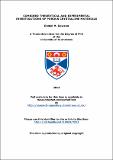Files in this item
Combined theoretical and experimental investigations of porous crystalline materials
Item metadata
| dc.contributor.advisor | Ashbrook, Sharon E. | |
| dc.contributor.author | Dawson, Daniel M. | |
| dc.coverage.spatial | xvi, 416 | en_US |
| dc.date.accessioned | 2015-07-28T14:02:00Z | |
| dc.date.available | 2015-07-28T14:02:00Z | |
| dc.date.issued | 2014-06-25 | |
| dc.identifier.uri | https://hdl.handle.net/10023/7053 | |
| dc.description.abstract | This thesis combines solid-state nuclear magnetic resonance (NMR) spectroscopy, X-ray diffraction (XRD), chemical synthesis, isotopic enrichment and density-functional theory (DFT) calculations to provide insight into a number of microporous materials. The first class of materials studied is metal-organic frameworks (MOFs), where the presence of paramagnetic ions has a range of effects on the ¹³C NMR spectra, depending on the nature of the ligand-metal interactions. For the Cu²⁺-based MOFs, HKUST-1 and STAM-1, the assignment of the NMR spectra is non-intuitive, and unambiguous assignment requires specific ¹³C labelling of the organic linker species. It is shown that ¹³C NMR spectra of these two MOFs could act as a sensitive probe of the nature of “guest” molecules bound to the Cu²⁺. The second class of materials is aluminophosphates (AlPOs). It is shown that, using a series of relatively simple linear relationships with the crystal structure, the NMR parameters calculated by DFT (with calculation times of several hours) can be predicted, often with experimentally-useful accuracy, in a matter of seconds using the DIStortion analysis COde (DISCO), which is introduced here. The ambient hydration of the AlPO, JDF-2, to AlPO-53(A) is shown to occur slowly, with incomplete hydration after ~3 months. The resulting AlPO-53(A) is disordered and some possible models for this disorder are investigated by DFT. The final class of materials is gallophosphates (GaPOs), particularly GaPO-34 and related materials. The two as-prepared forms of GaPO-34 are characterised by solid-state NMR, and their calcination investigated by TGA and in-situ powder XRD. An unusual dehydrofluorinated intermediate phase is isolated and characterised for the first time by solid-state NMR. The fully calcined material is shown to be stable under anhydrous conditions, but hydrates rapidly in air. The hydrated material is stable under ambient conditions, but collapses upon heating. Partial dehydration without collapse is achieved by gentle heating or room-temperature evacuation. The impurity phases, GaPO₄ berlinite and GaPO-X are investigated by solid-state NMR and, while the structure of GaPO-X remains unknown, much structural information is obtained. | en_US |
| dc.language.iso | en | en_US |
| dc.publisher | University of St Andrews | |
| dc.rights | Creative Commons Attribution-NonCommercial-NoDerivatives 4.0 International | |
| dc.rights.uri | http://creativecommons.org/licenses/by-nc-nd/4.0/ | |
| dc.subject | Solid-state NMR | en_US |
| dc.subject | Spectroscopy | en_US |
| dc.subject | Crystallography | en_US |
| dc.subject | Density functional theory | en_US |
| dc.subject | Microporous materials | en_US |
| dc.subject | Isotopic enrichment | en_US |
| dc.subject | Paramagnetic | en_US |
| dc.subject | Metal-organic framework | en_US |
| dc.subject | Aluminophosphate | en_US |
| dc.subject | Gallophosphate | en_US |
| dc.subject | Zeolite | en_US |
| dc.subject.lcc | QP173.4P67D2 | |
| dc.subject.lcsh | Porous materials | en_US |
| dc.subject.lcsh | Crystallography | en_US |
| dc.subject.lcsh | Nuclear magnetic resonance spectroscopy | en_US |
| dc.subject.lcsh | X-rays--Diffraction | en_US |
| dc.title | Combined theoretical and experimental investigations of porous crystalline materials | en_US |
| dc.type | Thesis | en_US |
| dc.type.qualificationlevel | Doctoral | en_US |
| dc.type.qualificationname | PhD Doctor of Philosophy | en_US |
| dc.publisher.institution | The University of St Andrews | en_US |
This item appears in the following Collection(s)
Except where otherwise noted within the work, this item's licence for re-use is described as Creative Commons Attribution-NonCommercial-NoDerivatives 4.0 International
Items in the St Andrews Research Repository are protected by copyright, with all rights reserved, unless otherwise indicated.


